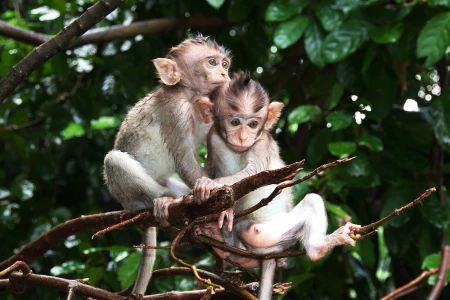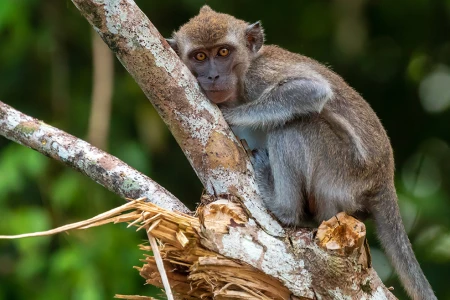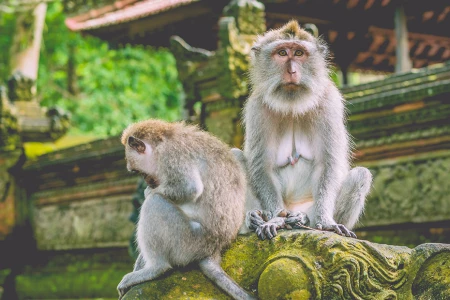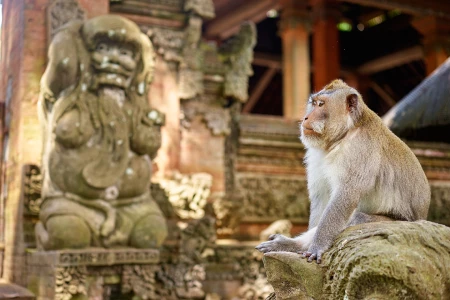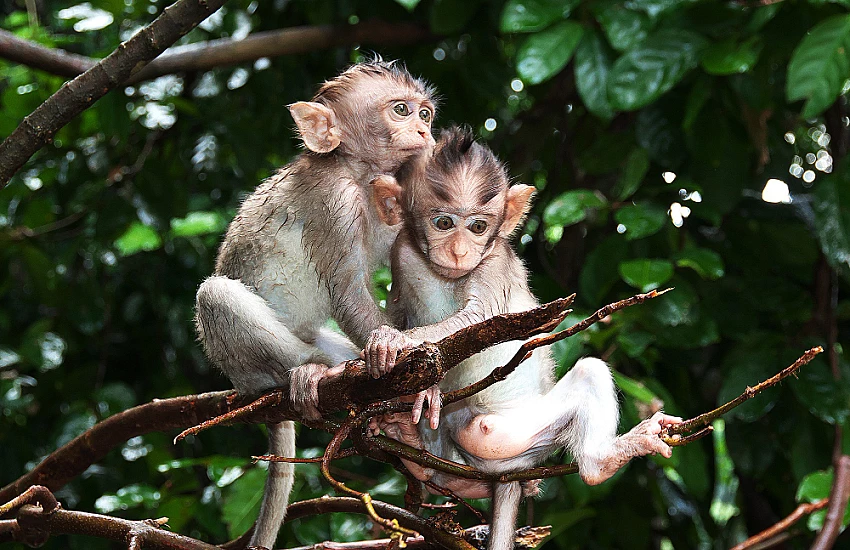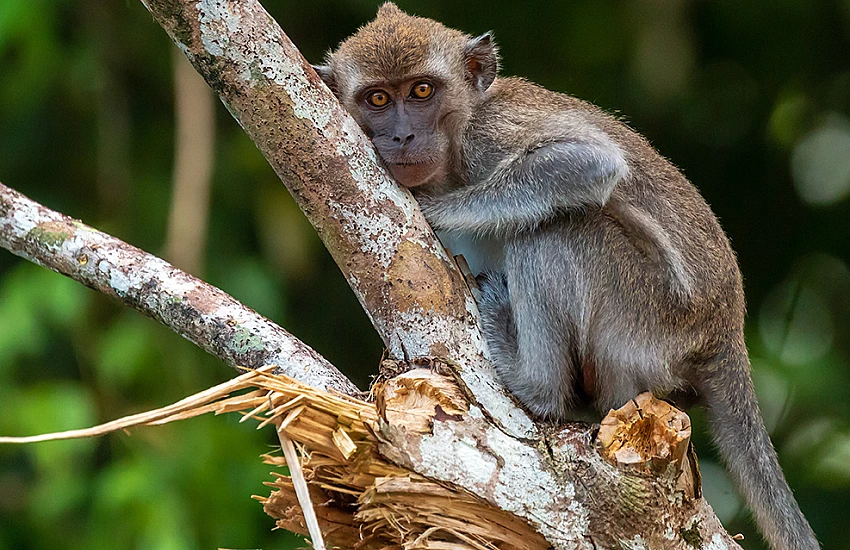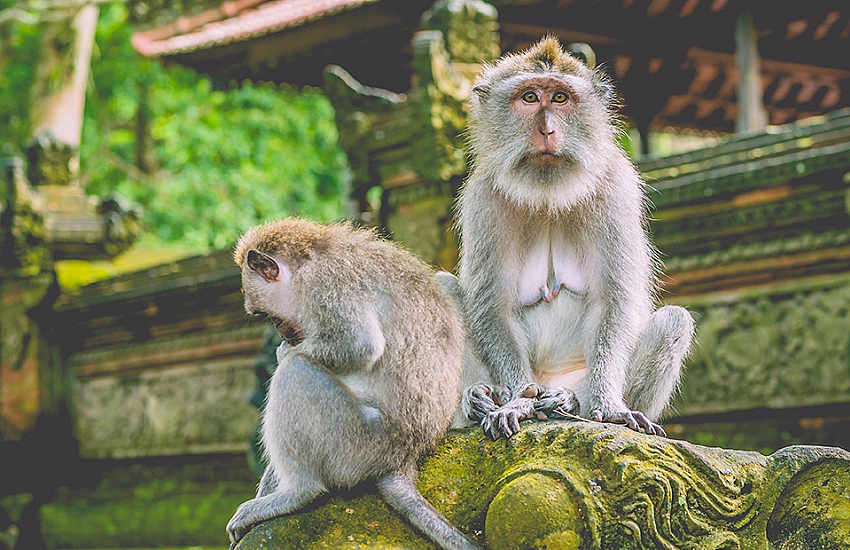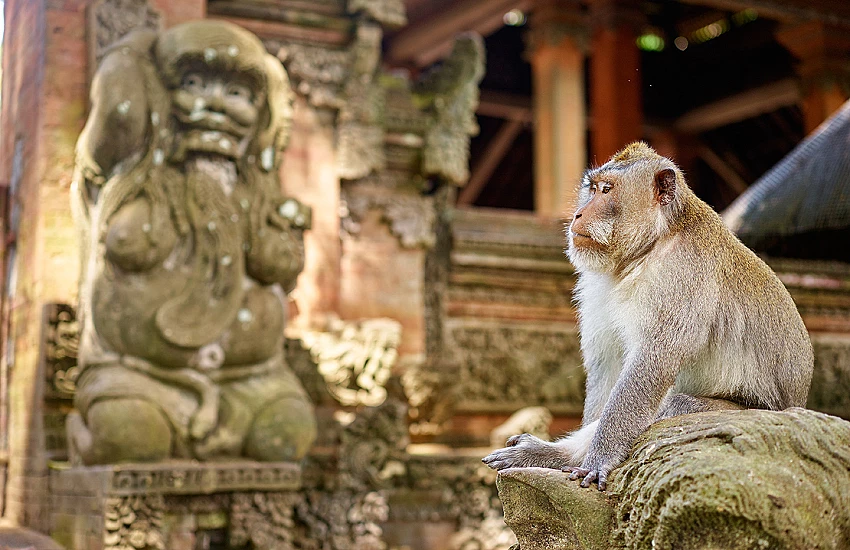
Table of Contents
The Ubud Monkey Forest, or Mandala Suci Wenara Wana, is far more than a lush sanctuary for playful long-tailed macaques; it stands as a profound testament to the intricate tapestry of Balinese culture and spirituality. Nestled in the heart of Ubud, this forest is a living embodiment of the Balinese philosophy of Tri Hita Karana, which emphasizes harmony among people, nature, and the divine.
At first glance, visitors might be captivated by the forest's verdant beauty and its charismatic primates. However, to truly appreciate this place is to delve into its sacred underpinnings. The forest houses three revered temples: Pura Dalem Agung Padangtegal, Pura Beji, and Pura Prajapati. Each temple holds significant religious value and serves distinct spiritual purposes for local communities. Pura Dalem Agung Padangtegal is dedicated to Shiva—the Hindu god of destruction—reflecting themes of life cycles and renewal that resonate deeply within Balinese spiritual practice.
Navigating through this sacred space requires more than just physical exploration; it invites a journey into understanding how deeply intertwined spirituality and daily life are in Bali. The temples are not mere architectural wonders but active sites of worship where rituals are performed regularly by locals seeking blessings or purification. Respecting these cultural nuances is essential for any visitor wishing to engage meaningfully with the site.
Observing local customs—such as dressing modestly near temple areas or refraining from intrusive behavior—honors both the sanctity of these spaces and their ongoing significance in Balinese life. In essence, experiencing Ubud Monkey Forest transcends ordinary tourism; it offers an immersion into a realm where nature's wild beauty meets humanity's profound quest for spiritual equilibrium.
Wildlife Encounters: Meeting The Monkeys Of Ubud
Nestled in the heart of Ubud, the Sacred Monkey Forest Sanctuary offers more than just a stroll through lush greenery; it’s an invitation to experience an intimate encounter with nature's playful primates. As you wander along the shaded pathways, you are greeted by the sight of long-tailed macaques swinging from tree branches and darting across ancient temple ruins. These charismatic creatures, with their expressive faces and curious eyes, are undeniably the stars of this verdant haven.
The macaques here are divided into five distinct groups, each claiming a different territory within the forest. Observing their interactions provides a fascinating glimpse into their social structures and behaviors. You might witness mothers tenderly grooming their young or see dominant males asserting their status through bold displays. The juveniles often exhibit boundless energy, chasing one another in exuberant games that showcase their agility and playfulness.
While these monkeys are accustomed to human presence, it’s crucial to approach them with respect and caution. The sanctuary staff provides guidance on how to interact safely with these wild inhabitants. Visitors are advised not to feed the monkeys as it disrupts their natural foraging behaviors and can lead to aggressive encounters.
Beyond mere observation, your time in Ubud Monkey Forest can become a deeply reflective experience. The forest serves as a reminder of our connection to nature and the importance of preserving such sanctuaries for future generations. The intertwining of sacred temples with untamed wildlife creates an atmosphere where spirituality meets raw natural beauty.
In essence, meeting the monkeys of Ubud is more than just a wildlife encounter; it's an immersion into a world where every rustle in the leaves or chattering call tells a story of life thriving amidst age-old traditions and untouched wilderness.
Preserving Paradise: Conservation Efforts And Challenges
Preserving the delicate balance of the Ubud Monkey Forest is a formidable task, fraught with both triumphs and tribulations. The sanctuary is more than just a tourist attraction; it's a vital conservation area for the long-tailed macaques (Macaca fascicularis) that call it home. Efforts to maintain this paradise involve meticulous planning and collaboration between local authorities, conservationists, and researchers.
One of the primary challenges in preserving this lush haven lies in managing human-wildlife interactions. With thousands of visitors flocking to the forest each year, there's an ever-present risk of habitat degradation and behavioral changes in the macaques. To mitigate these effects, strict guidelines have been established for tourists, including prohibitions against feeding or touching the animals. Educational programs aim to foster respect and understanding among visitors about the importance of maintaining natural behaviors in wildlife.
Another significant hurdle is ensuring genetic diversity within the monkey population. Overpopulation can lead to inbreeding and resultant health issues. To address this, periodic studies are conducted to monitor genetic variation and overall health metrics within groups of macaques. When necessary, controlled relocation efforts are undertaken to introduce new genetic lines from other areas.
Environmental sustainability also plays a crucial role in preserving this sanctuary's integrity. Reforestation projects help restore native plant species that provide food and shelter for the monkeys while also enhancing biodiversity within the forest ecosystem itself. Additionally, waste management systems have been improved to minimize pollution and protect water sources critical to both flora and fauna.
Despite these concerted efforts, challenges remain persistent—from climate change impacting habitats to funding constraints limiting expansive projects. Yet through continued vigilance and community involvement, Ubud Monkey Forest stands as a testament to what dedicated conservation can achieve amidst adversity.
Visitor Guidelines: How To Interact Safely And Respectfully
When visiting the Ubud Monkey Forest, it's essential to approach the experience with both excitement and mindfulness. As a sanctuary that marries the spiritual with the untamed, this sacred site demands respectful interaction for both its human visitors and its resident macaques.
To begin with, understanding the monkeys' natural behavior is crucial. These creatures are wild animals, not pets or performers. Observing them from a safe distance allows them to go about their daily activities without feeling threatened or stressed. While they may seem curious and even playful at times, it's important to remember they can also be unpredictable. Refrain from making direct eye contact or sudden movements that could be perceived as aggressive.
Respect extends beyond physical interaction; it encompasses how we engage with our surroundings as well. The forest is not just a home for monkeys but also a revered spiritual place for locals. Maintaining its sanctity involves keeping noise levels down and avoiding any actions that could disrupt the tranquility of this environment.
Feeding the monkeys is another area where guidelines must be strictly followed. While it might be tempting to share your snacks, doing so can encourage aggressive behavior and disrupt their natural diet. The forest management provides specific feeding areas where appropriate food is given under controlled conditions.
Personal belongings should also be managed carefully; monkeys are naturally inquisitive and have been known to snatch bags, sunglasses, and other items out of curiosity. Secure your belongings tightly to avoid any unwanted interactions.
Lastly, always follow instructions from guides or posted signs within the forest. These guidelines are designed not only for your safety but also for preserving the delicate balance of this unique ecosystem.
By adhering to these principles of respect and caution, you contribute to a harmonious coexistence between humans and nature in one of Bali's most cherished sanctuaries.
Beyond The Forest: Other Attractions In Ubud
Beyond the dense canopies and playful primates of the Ubud Monkey Forest, Ubud itself offers a rich tapestry of attractions that beckon travelers to delve deeper into Bali's cultural and natural wonders. As you step outside the forest's verdant embrace, you’ll find an array of experiences that embody the essence of Balinese life. A short stroll from the forest brings you to Ubud Palace, or Puri Saren Agung.
This historical edifice stands as a testament to Bali’s regal past. Intricate carvings and traditional Balinese architecture make it a visual feast, while its evening dance performances offer a mesmerizing glimpse into age-old cultural expressions. Adjacent to the palace is the bustling Ubud Art Market. Here, artisans display their exquisite handicrafts, from delicate silk scarves to elaborate wood carvings. The market is more than just a shopping destination; it’s a vibrant hub where you can witness local craftsmanship in action and perhaps even engage in friendly bargaining—an integral part of Balinese commerce.
For those seeking tranquility amid nature's splendor, Tegallalang Rice Terraces are just a short drive away. These iconic terraces are not only an agricultural marvel but also a serene escape for those looking to capture Bali’s scenic beauty through photography or simply enjoy a peaceful walk among the lush paddies. Art enthusiasts will find sanctuary in Ubud’s numerous galleries and museums.
The Neka Art Museum houses an impressive collection of traditional and contemporary Balinese art, offering insights into the island’s evolving artistic landscape. As your day winds down, consider visiting one of Ubud's many wellness retreats or yoga studios. These sanctuaries provide rejuvenating experiences designed to harmonize mind, body, and spirit—a perfect conclusion after exploring both sacred sites and wild landscapes that define this enchanting town.






